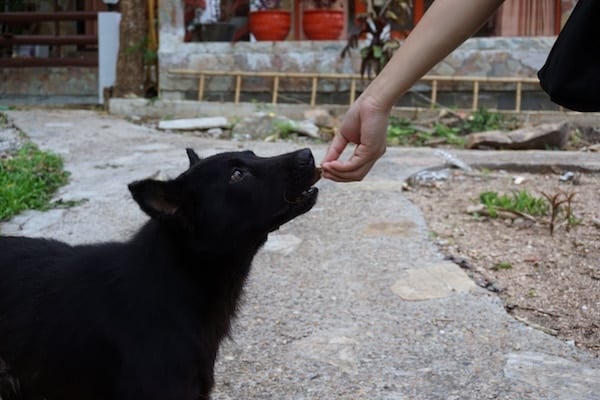- Not a substitute for professional veterinary help.
Is your dog afraid of everything? Some dogs find the world an overwhelming place and experience fear in everyday situations. They might react to scary encounters with trembling, hiding, tucking their tail, or lowering their posture. While fear is a natural survival instinct, it becomes problematic when it interferes with daily life.
Since fear can deepen over time and rarely resolves without some kind of intervention, it’s not something you want to ignore. The good news is that there are ways to help your dog manage their fears and live a happy, peaceful life.
To get a handle on this tricky issue, we consulted three veterinarians. In this article, we’ll outline common causes of dog fear and share effective training strategies to help them feel more at ease. We’ll also discuss when professional help may be necessary.
Causes of Generalized Fear
The reason your dog is afraid of everything can be complex and influenced by multiple factors, says Dr. Edward Bassingthwaighte of The Healing Vet. Understanding the root cause of your dog’s fears can help point you toward the proper solution. We lay out some common causes below.
Fear periods
If your dog is suddenly afraid of everything, they may be going through a fear period.
This is a normal and temporary developmental stage that occurs twice during puppyhood. You may notice your puppy is suddenly cautious around things they previously enjoyed, like meeting new people or exploring new places. They might even be scared of peculiar items like a broom or a bag blowing in the wind.
The best way to help your puppy is to wait it out, take it easy with training and socialization, and avoid stressful situations until the fear period passes.
Fearful breeds
Fear can also be influenced by a dog’s genetics. If a dog’s parents are nervous, there’s a good chance their puppies will inherit similar temperaments, explains Dr. Bassingthwaighte. Additionally, some breeds are more prone to fearfulness. High-energy and working breeds, in particular, tend to be more skittish. While these are generalizations and don’t apply to all dogs, some breeds known for fearful tendencies include:
- Border Collies
- Australian Shepherds
- Jack Russell Terriers
- Dalmatians
- Chihuahuas
- Greyhounds
- Whippets
- Dachshunds
- Cavalier King Charles Spaniels

koldunova via iStock
General anxiety
If your dog is afraid of everything, underlying anxiety may be to blame. General anxiety can arise from a mix of genetic factors, negative early experiences, limited socialization, and trauma. Dr. Nell Ostermeier, veterinary advisor at OnePack Plan by PetPartners, adds that some dogs can become increasingly anxious as they age.
Some dogs are also more sensory-sensitive, says Dr. Aimee Warner, resident veterinarian at Waggel. These dogs might react fearfully to things we consider harmless, like sudden movements, walking on new surfaces, or everyday noises like hairdryers or vacuum cleaners.
General anxiety in dogs can manifest in various ways. Some dogs may become destructive; others might bark excessively or appear distracted. Compulsive behaviors like tail chasing can also indicate general anxiety in dogs.
Trauma and rescue dogs
Fear often follows traumatic experiences. All it takes is one negative experience to create a lasting effect. For instance, if your pet is attacked by an off-leash dog on a walk, they may become fearful of all dogs in the future. They may also generalize that fear and become scared of the place where the fight occurred or be afraid to go on walks altogether.
Rescue dogs in particular may be at a greater risk for trauma-based fear. Dr. Warner notes this is frequently linked to a history of abuse, repeated rehoming, or prolonged confinement. Coming from a traumatic background can make these dogs feel unsafe, even in a loving and stable home.
Injuries and health issues
Certain medical issues that cause pain or discomfort can trigger fearful behavior as well. Conditions like arthritis, hypothyroidism, or neurological disorders can lead to behaviors like hiding or avoiding touch. Your veterinarian can identify any underlying health issues that might be causing these fearful reactions.
Lack of socialization
The first few months of a puppy’s life are crucial for socialization. Dr. Warner explains that puppies not exposed to a variety of people, animals, sounds, and places during this critical window are more likely to be afraid of everything when they’re adults.
Studies show that dogs with limited socialization tend to develop fear both in social scenarios, such as meeting new dogs or people, and in non-social situations, like being exposed to loud noises or unfamiliar objects.
What To Do
Ongoing fear isn’t just unpleasant or inconvenient—it can lead to negative health consequences. Long-term fear can weaken your dog’s immune system, putting them at risk of illness and potentially shortening their lifespan. Fortunately, there are many ways to help your dog feel better and manage their fears.
Here’s what our experts recommend.
How to train your dog to be less afraid
Helping your dog overcome their fears is a multi-step process that typically includes the following.
1. Identifying triggers. Take note of what scares your dog. Recognizing these fears will help you limit exposure to triggers while you come up with a training plan to address them.
2. Pairing triggers with positive reinforcement. Using techniques such as counterconditioning and desensitization can be highly effective. These methods involve gradually exposing a dog to the trigger in a controlled setting and pairing the experience with something positive, like treats or praise.
Always keep your dog below their stress threshold—if they become reactive, you may need to remove them from the situation to de-escalate, says Dr. Ostermeier. An experienced trainer can be a huge help when implementing these training techniques.
3. Teaching alternative behaviors. Instead of barking, lunging, pulling, trying to escape, or reacting out of fear in another way, encourage your dog to perform a different behavior when they see a trigger. For example, you might train them to check in with you or give you a nose touch when they see a trigger.
4. Monitoring progress. “This is where we track what’s working, what isn’t, and make changes as needed to get the best potential outcomes,” explains Dr. Bassingthwaighte. Dr. Warner adds that creating a consistent daily routine will also help calm your dog’s nerves. Try to keep regular feeding, exercise, and sleep schedules to give your pup a sense of predictability.
As you work with your dog, don’t underestimate the value of positive reinforcement in building their confidence. “Rewarding desired behaviors—such as approaching a new object, calmly observing a stressful situation, or showing relaxed body language—teaches the dog that positive experiences follow bravery,” says Dr. Warner. It also builds trust between you and your dog.

Tanantornanutra via iStock
Tools
In addition to training, incorporating effective tools can help ease your dog’s fears.
- Calming treats. These dietary supplements contain calming ingredients like tryptophan and L-theanine. They’re designed to ease the nerves, especially for dogs with specific anxiety triggers, like thunderstorms or fireworks.
- Pressure wraps. Comforting apparel like the ThunderShirt uses gentle pressure to mimic a hug. These wraps can help with situationally nervous dogs.
- White noise machines. These devices drown out upsetting noises like traffic, barking, or construction. Alternatively, playing calm classical music in the background soothes some dogs.
- Toys. Keep your dog mentally stimulated and distracted with puzzle toys, snuffle mats, and lick mats. These engaging toys encourage naturally relaxing behaviors, like foraging, sniffing, and licking. Dr. Warner adds that they may also boost self-confidence and prevent stress associated with boredom.
- A cozy bed. Dr. Warner recommends creating a cozy refuge where your pup can retreat when they’re feeling overwhelmed. A soft, round, calming bed can provide a safe space for many nervous dogs.
When to consider medications
If your dog is struggling with fear, it might be time to explore anxiety medication as part of the solution. Not all dogs will benefit, but for some, medication can make training more effective. “Animals can become too upset in a state of extreme anxiety to learn anything new, and medication can serve to bridge the gap,” explains Dr. Warner.
To see if medication makes sense for your dog, first visit your vet to rule out any underlying health issues that could be contributing to your dog’s fears. You can then ask your vet if medication might be able to help.
Dr. Warner reminds us that while helpful in some cases, medication isn’t a cure-all, and it can’t replace training and behavior modification. Don’t hesitate to ask your vet if they can recommend a veterinary behaviorist for guidance. These specialized vets diagnose and treat behavioral issues and will work with your general vet and trainer (it takes a team!) to help you come up with a tailored treatment plan.
Finally, Dr. Ostermeier suggests discussing alternative treatments with your vet, such as acupuncture or herbal remedies.
What Not To Do
The last thing we want to do is add to our dogs’ stress. But a number of well-meaning actions can actually amplify your dog’s fears. Here are some behaviors to avoid with fearful dogs.
- Forcing dogs to face their fears. Pressuring your dog to confront their trigger, known as “flooding,” is never a good idea. Our experts advise against putting a dog in a frightening situation in the hopes that they will “get over it.” Instead of helping, this method typically backfires and increases a dog’s fear.
- Punishing fear behaviors. Avoid punishing your dog for actions like cowering, growling, or barking. Dr. Warner explains that these are a dog’s way of communicating distress. Punishing your dog won’t reduce their fear, but it could make them afraid of you.
- Displaying your own anxiety. Your dog can sense your emotions. If you become anxious, they may follow suit. Try to stay calm, cool, and collected so your dog knows they’re safe and everything is okay.
When To Get Help
While it can feel overwhelming, remember you are not alone with your dog’s fear. Dr. Ostermeier points out that professional trainers and behaviorists can work collaboratively with your veterinarian for the best results.
Here are some clues that it’s time to reach out to a professional.
- Your dog’s fear is severe. Dr. Ostermeier advises seeking help if your dog’s fear episodes are intense, even if they are intermittent. This is especially true for dogs who react with self-harm or aggression toward others.
- Decreased quality of life. Unaddressed fear can keep dogs from being active and happy in their everyday life. If your dog is not eating, hiding for long periods, or showing reactive behavior in daily situations, it’s time to consult a veterinarian, behaviorist, or trainer.
- Ineffective home training. While many cases of fear can be managed at home, some require outside help. If your dog isn’t making progress, a certified trainer or veterinary behaviorist can create a personalized treatment plan with step-by-step exercises.
As you work on relieving your dog’s fears, patience is key. Remember, it may take time to see progress, and rushing the process can lead to setbacks or increase your dog’s fears. The best way to support your pup is to go at their pace, rewarding baby steps along the way.



